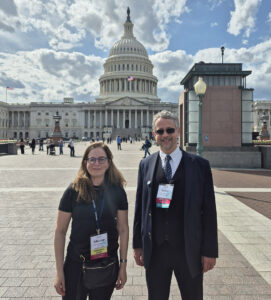
Gabor Balazsi, Ph.D.
AIMBE College of Fellows Class of 2025 For pioneering contributions to apply engineering principles to design protein-level tuning synthetic gene circuits, and to identify mechanisms for their evolution.
Stony Brook Faculty Join Capitol Hill Day to Champion Federal Support for Biomedical Research
Via Stony Brook University | April 9, 2025On March 31, two leading biomedical researchers from Stony Brook University, Lilianne Mujica-Parodi and Gábor Balázsi, joined with colleagues from across the country in Washington, D.C., to meet with congressional offices to discuss the importance of robust federal funding for biomedical research during at The American Institute for Medical and Biological Engineering (AIMBE)’s Capitol Hill Day.

SBU biomedical researchers Lilianne Mujica-Parodi and Gábor Balázsi.
Mujica-Parodi and Balázsi engaged with New York congressional delegation staff to emphasize the critical need for continued and increased federal investment in biomedical science. With the crucial need for the advancement of biomedical technologies and innovations, these researchers underscored how federal support is essential not only for academic and clinical advancements but also for training and retaining top-tier talent in the United States… Continue reading.
...Gabor Balazsi Inducted into the 2025 Class of the AIMBE College of Fellows
Via AIMBE | March 31, 2025WASHINGTON, D.C. – The American Institute for Medical and Biological Engineering (AIMBE) has announced the induction of Gabor Balazsi, Ph.D., Henry Laufer Professor of Physical and Quantitative Biology of Laufer Center and Biomedical Engineering Department at Stony Brook University to its College of Fellows.
Election to the AIMBE College of Fellows is among the highest professional distinctions accorded to medical and biological engineers, comprised of the top two percent of engineers in these fields. College membership honors those who have made outstanding contributions to “engineering and medicine research, practice, or education” and to “the pioneering of new and developing fields of technology, making major advancements in traditional fields of medical and biological engineering or developing/implementing innovative approaches to bioengineering education.”
Professor Balazsi was nominated, reviewed, and elected by peers and members of the College of Fellows “for pioneering contributions to apply engineering principles to design protein-level tuning synthetic gene circuits, and to identify mechanisms for their evolution…. Continue reading.
... AIMBE
AIMBE
